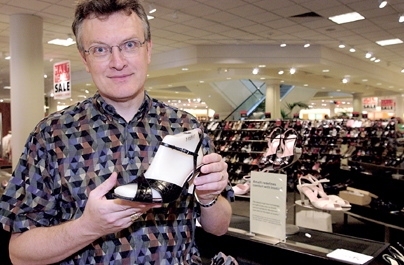Love the look of high heels, but can't stand the pain? MIT alumni Brian G.R. Hughes (S.B. 1977) and Paul Rudovsky (S.B. 1966) believe a long overdue injection of high-tech engineering called Insolia® may be just what the foot doctor ordered.
"It's classic MIT approach. This is a fundamental problem to which people have assumed there is no solution," said Hughes.
Hughes and Rudovsky met while serving on the MIT Corporation in 1996, and neither of the former Alumni Association presidents expected to be involved in the fashion industry. Hughes' resumé includes building the first private trans-Atlantic telecommunication system and running his own hybrid rocket development company. Rudovsky has served as CFO of several public and private companies as well as CEO of a clothing manufacturer.
Ironically, it was Hughes, the former rocket builder, who approached Rudovsky about investing in HBN Shoe, makers of shoes that contain Insolia, a "weight-shift" technology invented by a New Hampshire-based podiatrist. By 2002, HBN (named after partners Howard Dananberg, the podiatrist, and MIT alumni Beth Marcus and Nick Soloway) had switched from a grassroots marketing strategy to a technology licensing strategy and Rudovsky had signed on as CFO.
Currently, Insolia is already utilized in women's shoes sold in the United States, China, Hong Kong, Japan, Canada and the Czech Republic.
The ramp of pain
All podiatrists know the problem with high heels. Standard construction of the shoes creates a "ramp effect"--the foot slides toward the toe box, creating continuous pressure on the digits and ball of the foot. Bunions, hammer toes and a painful thickening of the nerves between the toes as well as ankle, knee and back pain often result.
But what if the ramp could shift more weight back to the heel? Using F-Scan, a flexible computer pressure mapping system, Dananberg created Insolia--insole boards that put the foot in optimal position at various specific heel heights.
The Insolia formula combines a heel cup with a precisely located mid-sole bump. As Hughes explained it, "about 25 percent of the weight that would have slid down to the toe remains back at the heel. Cupping the heel increases the contact area and reduces the peak force by 50 percent. It creates the very strong illusion that you are wearing a heel that is about half the height of the one you are actually wearing."
High-heeled shoes with Insolia technology look outwardly just like their punitive kin. But inside--a world of difference awaits. Blind studies commonly result in Insolia wearers describing a "thick, wonderful padding. But there is no padding. It's all geometry," said Hughes.
Insolia made its American debut in Nordstrom stores in May in Amalfi brand high heels. Only the Insolia logo on the sole or trying them on will reveal the cup-and-bump technology, Hughes noted.
"My working definition of success will be when I walk into Saks Fifth Avenue and watch somebody look at a pair of shoes and the first thing they do is look on the bottom for our logo," said Hughes.
A version of this article appeared on the MIT Alumni Association's web site.
A version of this article appeared in MIT Tech Talk on September 29, 2004 (download PDF).






